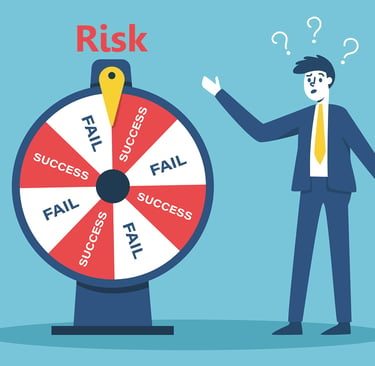THE ENTREPRENEURIAL BOARD
The Psychology of Risk Taking: Lessons from Thinking, Fast and Slow
Khushi Mittal & Prakhar Gupta
11/15/20242 min read


Risk forms an integral part of an entrepreneur’s experience. After all, who doesn’t know that any choice entails uncertainty – whether it’s choosing a piece of furniture or a business venture? Nobel laureate Daniel Kahneman, in his book Thinking, Fast and Slow, explores the psychology of decision-making and provides insight into cognitive errors that determine how we view and take risks. Awareness of these patterns can be a game-changer, making entrepreneurs more thoughtful and strategic about the choices they make.
Here’s a look at some of these biases and practical tips on managing them:
Loss Aversion: When the Fear of Loss Holds You Back
What is it? Loss aversion is the tendency to fear losses more than we value gains. For example, the pain of losing ₹1 crore exceeds the pleasure obtained from gaining ₹1 crore.
How it shows up: In your entrepreneurial self, it might manifest as excessive caution, preventing you from taking necessary risks to grow.
What You Can Do: Begin to demystify the idea that risk equals loss and highlight the opportunity to learn. Determine what limits on losses you are willing to accept in any given investment, start small in scope, and test hypotheses to become comfortable with this new concept.
Overconfidence Bias: Thinking You’re 100% Right (When You Might Not Be)
What does it mean? Entrepreneurs often possess confidence – a necessary trait to weather tough times. However, overconfidence can cause you to overlook risks and overestimate the chances of succeeding.
How it shows up: You might neglect wise advice, leap into decisions without a plan, or set unrealistic goals.
What You Can Do: Test your confidence by seeking outside perspectives. Consult mentors, develop “what-if” scenarios, and regularly assess your progress.
Probability Neglect: Fear of Rare Risks Over Likely Ones
What is it? Probability neglect refers to worrying about low-probability events while ignoring higher-probability ones. For example, fearing plane crashes more than car accidents, despite the latter being more likely.
How it shows up: You might become fixated on improbable, cataclysmic risks, ignoring real ones that are likely to have an impact.
What You Can Do: Use data to inform your decisions, focusing on high-probability risks. Don’t let low-probability fears distract you.
Anchoring: Getting Stuck on First Impressions
What does it mean? Anchoring occurs when we give excessive weight to initial information, even if later information is more relevant.
How it shows up: You’re emotionally invested in your initial product price or marketing strategy, despite subsequent research suggesting a pivot.
What You Can Do: Consider multiple viewpoints and data points before acting. Test assumptions, especially those based on first impressions.
Planning Fallacy: Underestimating Time and Costs
What is it? The planning fallacy involves underestimating the time or cost required for a project.
How it shows up: You set ambitious timelines or budgets, only to experience stressful crunch times and stretched resources.
What You Can Do: Add padding to timelines and budgets for new projects. Consult others who have done similar work to estimate more accurately.
Building a business requires balancing risk and reward. Understanding biases like loss aversion, overconfidence, and the planning fallacy will help you make smarter choices, balancing risk with opportunity. Calculated risks can then be taken to achieve sustainable growth.
Have you faced any of these biases in your decision-making? Share your stories on how you managed risk throughout your entrepreneurial journey.
